
The history of the Ōmi cattle
The history around the Ōmi cattle
| The Edo Period | In 1590 | Tensho 18years | When Toyotomi Hideyoshi did Odawara siege,Takayama Ukon had behaved beef to Gamo Ujisato and Hosokawa Tadaoki. |
|---|---|---|---|
| In 1687 | Genroku era | The Hikone domain devised miso pickles of the beef. It was named "Henpongan". |
|
| In 1771 | Anei era | The Hikone beef was served to feudal lords. | |
| In 1781 | Tenmei era | The Hikone domain presented the miso beef to Ienari of shogun. | |
| In 1788 | Kansyo era | Hikone domain started drying beef recipe, and presented them to the Ienari of shogun. | |
| In 1848 | Kaei era | In Gamo district, raising of the cattle began by instruction of the Bishu clansman. | |
| In 1853 | Ansei era | Kanji of Uoya town Hikone displayed a signboard of Hikone cattle and started a business in Edo era. Naosuke Ii stopped annual beef presentation to Mito Nariaki for prohibition on hunting and fishing | |
| In 1866 | Keiou era | Beef produced in Goshu Hikone is sold as medicine. “Beef Nabe Store” opens. | |
| The Meiji Period | In 1869 | Meiji2 | Driving cattle for 17 ~ 18 days, traders reach Yokohama and begin trading with foreign parties directly. |
| In 1877 | Meiji10 | 50 slaughters a day are conducted in Ousaka, Musa, Omachi, Toyosato, and Imazu | |
| In 1879 | Meiji12 | Kyuji Takenaka opens “Yonekyu”, a beef wholesale/retail store, in Tokyo. 40 slaughters a day are conducted, mainly Ōmi brands. | |
| In 1882 | Meiji15 | Shipping of cattle to Tokyo via Kobe port begins. | |
| In 1884 | Meiji17 | Shipping of cattle to Tokyo via Yokkaichi port begins. | |
| In 1887 | Meiji20 | Slaughter regulation law is enacted. Slaughter figures in Tokyo, 20,000. (By region: Ōmi 33%, Settsu 32%, Banshu 11%, Ise 7%). | |
| In 1890 | Meiji23 | Using the Tokaido Line that opened on the previous year, shipment of cattle from Yahata station begins. | |
| In 1892 | Meiji25 | Cattle plague spreads from the Korean peninsula, shipment of cattle is banned. | |
| In 1907 | Meiji40 | Shouzouou Nishii, pioneer of Ōmi Cattle, establishes the Gamō District Cattle Horse Union. | |
| In 1910 | Meiji43 | Livestock market law is enacted. Prefecture livestock market union, Kusatsu, Yokaichi, and Kibukawa markets are established. | |
| In 1911 | Meiji44 | A permanent livestock market is established (Kusatsu, Kibukawa, Kotou, Yokaichi, Seta, Yasu, Nishioshitate, Kinomoto). | |
| Taisho Showa Heisei |
In 1906 | 大正3 | The National Livestock Exhibition is held in Ueno Park, Tokyo. Cattle from the Gamō district wins first prize. |
| In 1932 | Showa6 | The prefecture establishes a stud in Ichimiyake, Yasu city. | |
| In 1935 | Showa10 | Cattle from the Gamō district wins 3rd prize at the Tokyo Shibaura Livestock Market competition. | |
| In 1942 | Showa17 | The enactment of heifer loaning promotes the breeding of Japanese Beef. | |
| In 1948 | Showa23 | Livestock department is established in the Shiga prefecture office. | |
| In 1951 | Showa26 | Ōmi Beef Association is established. | |
| In 1952 | Showa27 | Kinki Tokai Hokuriku Beef Cattle Exhibition (1st) is held. | |
| In 1954 | Showa29 | Large-scaled advertisement is held at Nihonbashi Shirokiya. | |
| In 1959 | Showa34 | Attempts production of beef cattle through Japanese Beef production training projects and livestock placement projects. | |
| In 1962 | Showa37 | Shiga prefecture Livestock Trade Union is established. | |
| In 1966 | Showa41 | “Shiga Local Wholesale Meat Market Co., Ltd.” is established. | |
| In 1991 | Heisei3 | Beef trade is liberalized. | |
| In 2005 | Heisei17 | “Ōmi Beef” is defined. | |
| In 2007 | Heisei19 | Shiga Meat Center begins its operations. | |
| In 2007 | Heisei19 | “Ōmi Beef” is registered as a local trademark. | |
| In 2007 | Heisei19 | “Ōmi Beef” Production/Logistics Promotion Association is established. | |
| In 2008 | Heisei20 | “Ōmi Beef” certification system begins. | |
| In 2009 | Heisei21 | Certified “Ōmi Beef” Store system begins. |
During the Edo era, beef was used as medicine. 1687, in the Hikone Domain, Denemon Hanaki suggests to soak the beef intŌmiso, based on what he read in Bencao Gangmu by Li Shizhen. This is said to be the beginning of “Henpongan”. “Bencao Gangmu” was passed on from Ming during the Keicho years. In it, it states, “The meat of huángniú is sweet and harmless, it balances your insides, looks after your stomach, hips, and legs”. So, Henpongan was most likely made as a health preservative. At the time, you couldn’t eat beef in public, so maybe it was easier to call it medicine.
| Records show that during the Edo era, beef was dried in the Hikone Domain. Production of this dried meat began in early January, the coldest time of year, and lasted about a month. This was done to keep the salt contents of the meat to a minimum. This period was called “Kan”, and these “Kan” dried beef were used as medicine. There is a “Production Method” recipe left from that time. “Cut up the meat and take out the sinews during Kan, soak in spring water to eliminate the smell, steam it, attach strings to it, and dry them. If it’s not done during Kan, you must add salt to prevent the meat from being damaged. You can produce this during warm seasons if you use a lot of salt, but it loses its medicinal benefits, so it is of little use.” |
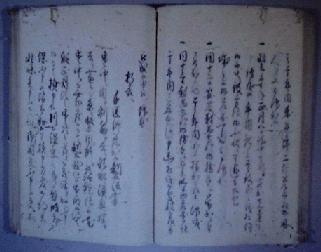 |
Gojoshi Yoriai Tomecho (Gojoshi’s Collective Notebook) (Hikone Jo Museum) |
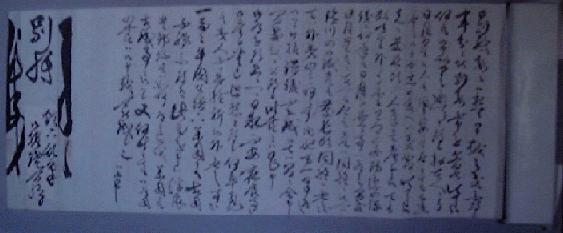
 |
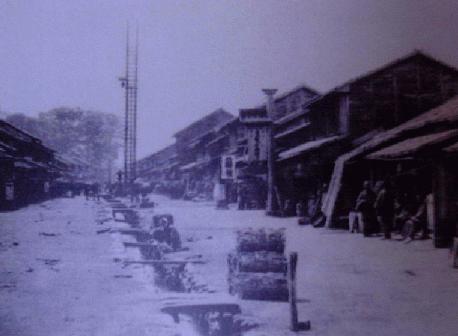 |
| Store that sells Hikone Beef in a Atsugi lodge at the end of the Edo era. (Yokohama Port Reference Museum “F. Beato Bakumatsu Photographs”) |
|
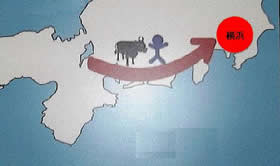 |
Around Meiji 5 (1872) * Shipment via Tokaido Line on land |
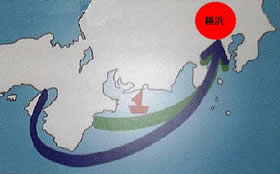 |
Around Meiji 15 ~ 17 (1882 ~ 1884) From Kobe Port to Shimoda Port, Livestock shipping to Yokohama Port (15~) (1882~) |
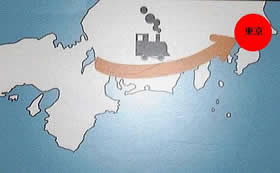 |
Around Meiji 25 (1892) * Shipment of dressed carcasses from Tokai Ōmi Hachiman Station to Tokyo. When shipped via railroads, it is easy to tell that it was loaded in Ōmi Hachiman Station, which made “Ōmi Beef” more famous. |
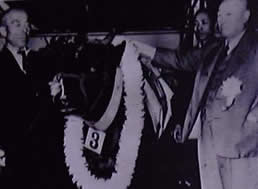 |
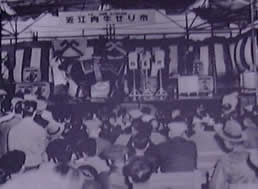 |
|
Mr. Tsutsumi, President of the House of Representatives awards a lei to an Ōmi Cattle. |
Auction sale of Ōmi Beef (Showa 29 (1954) Rooftop of Nihonbashi Shirokiya) |




